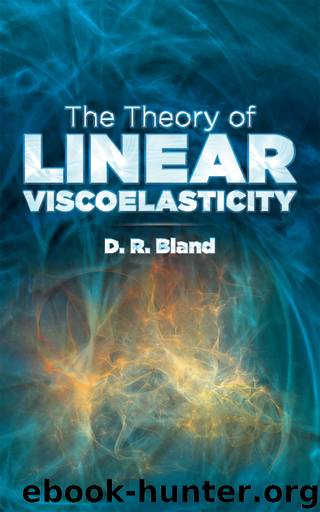The Theory of Linear Viscoelasticity by D. R. Bland

Author:D. R. Bland [D. R. Bland]
Language: eng
Format: epub
Publisher: INscribe Digital
Published: 2016-04-04T04:00:00+00:00
or
where Cj is a constant vector, possibly complex, Z is a complex constant and nk is the unit vector in the direction of propagation of the wave. Substitute from equation (25) into equation (11):
whenever
i.e.
This is a vector equation and therefore either the two vectors are equal in magnitude and direction or the two vectors both have zero coefficients. In the former case
and
where A is a complex constant; and in the latter case
and
The displacement uj in eq. (26) satisfies uj,i – ui,j = 0 and ui,i ≠ 0. The displacement uj in eq. (27) satisfies uj,j = 0 and uj,i – ui,j ≠ 0. The results of this paragraph can be summarized as
“The only plane sinusoidal waves possible in a linear viscoelastic material under no sinusoidal body force are a wave of dilatation and no rotation and a wave of rotation and no dilatation. In the former the motion is along the direction of propagation, and in the latter the motion is along any direction normal to the direction of propagation.”
This result is identical to that for an elastic medium.
The stress associated with either wave can be found by substitution from eq. (25) into eq. (10):
Download
This site does not store any files on its server. We only index and link to content provided by other sites. Please contact the content providers to delete copyright contents if any and email us, we'll remove relevant links or contents immediately.
| Automotive | Engineering |
| Transportation |
Whiskies Galore by Ian Buxton(41522)
Introduction to Aircraft Design (Cambridge Aerospace Series) by John P. Fielding(32881)
Small Unmanned Fixed-wing Aircraft Design by Andrew J. Keane Andras Sobester James P. Scanlan & András Sóbester & James P. Scanlan(32566)
Craft Beer for the Homebrewer by Michael Agnew(17925)
Turbulence by E. J. Noyes(7689)
The Complete Stick Figure Physics Tutorials by Allen Sarah(7134)
Kaplan MCAT General Chemistry Review by Kaplan(6582)
The Thirst by Nesbo Jo(6431)
Bad Blood by John Carreyrou(6268)
Modelling of Convective Heat and Mass Transfer in Rotating Flows by Igor V. Shevchuk(6218)
Learning SQL by Alan Beaulieu(6023)
Weapons of Math Destruction by Cathy O'Neil(5817)
Man-made Catastrophes and Risk Information Concealment by Dmitry Chernov & Didier Sornette(5638)
Digital Minimalism by Cal Newport;(5376)
Life 3.0: Being Human in the Age of Artificial Intelligence by Tegmark Max(5180)
iGen by Jean M. Twenge(5149)
Secrets of Antigravity Propulsion: Tesla, UFOs, and Classified Aerospace Technology by Ph.D. Paul A. Laviolette(4972)
Design of Trajectory Optimization Approach for Space Maneuver Vehicle Skip Entry Problems by Runqi Chai & Al Savvaris & Antonios Tsourdos & Senchun Chai(4837)
Electronic Devices & Circuits by Jacob Millman & Christos C. Halkias(4739)
